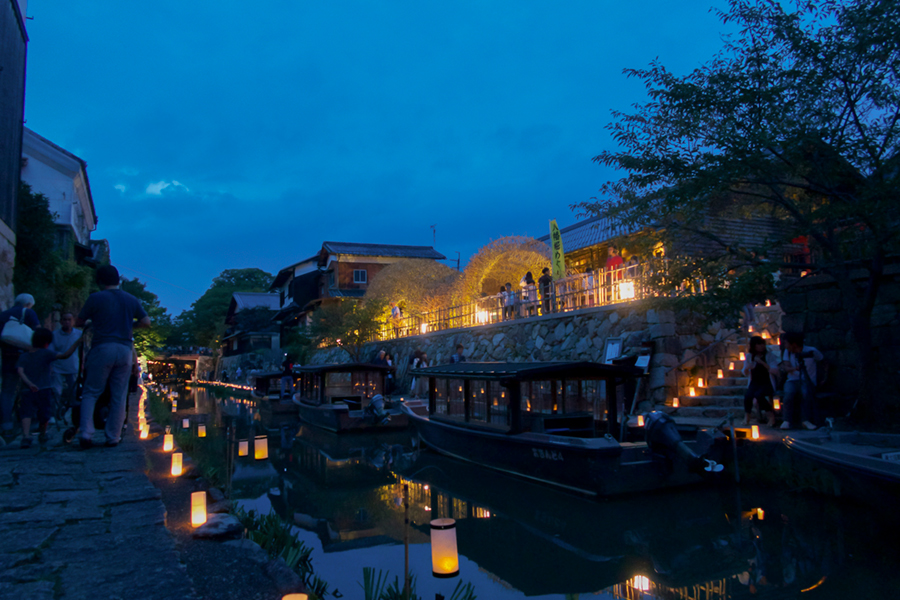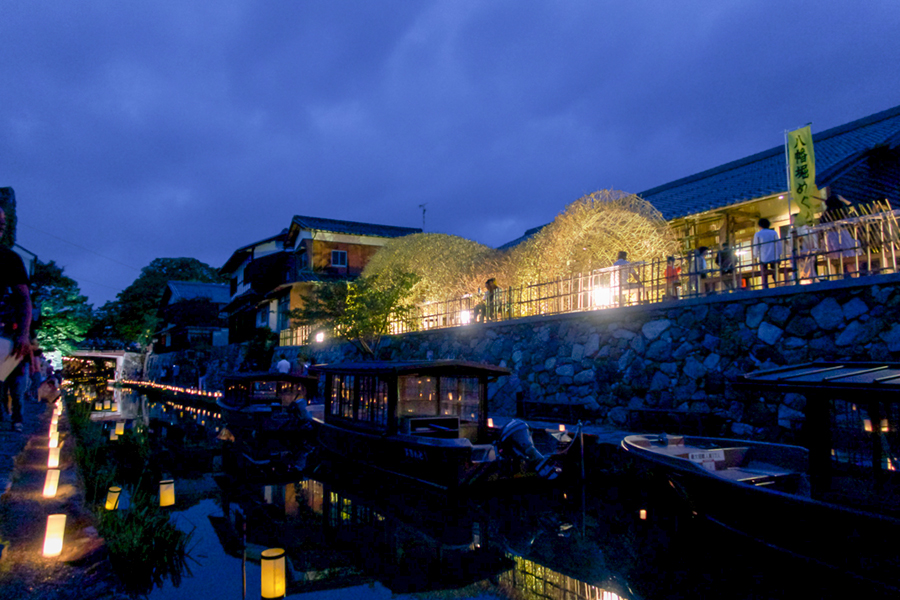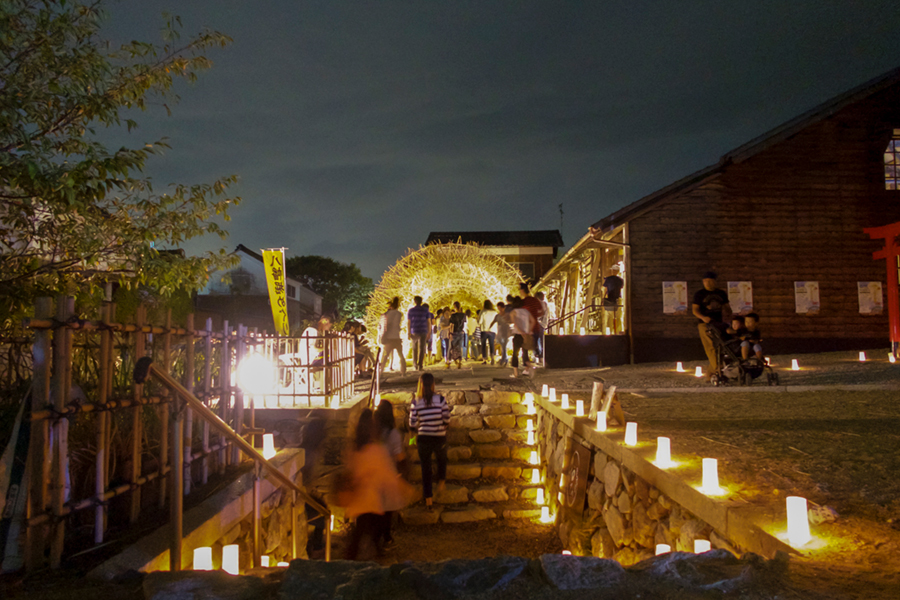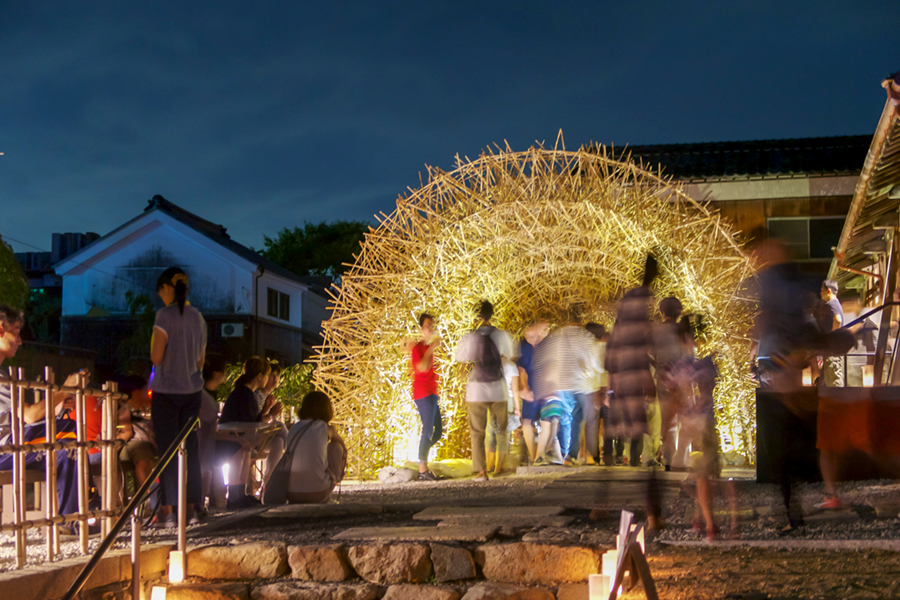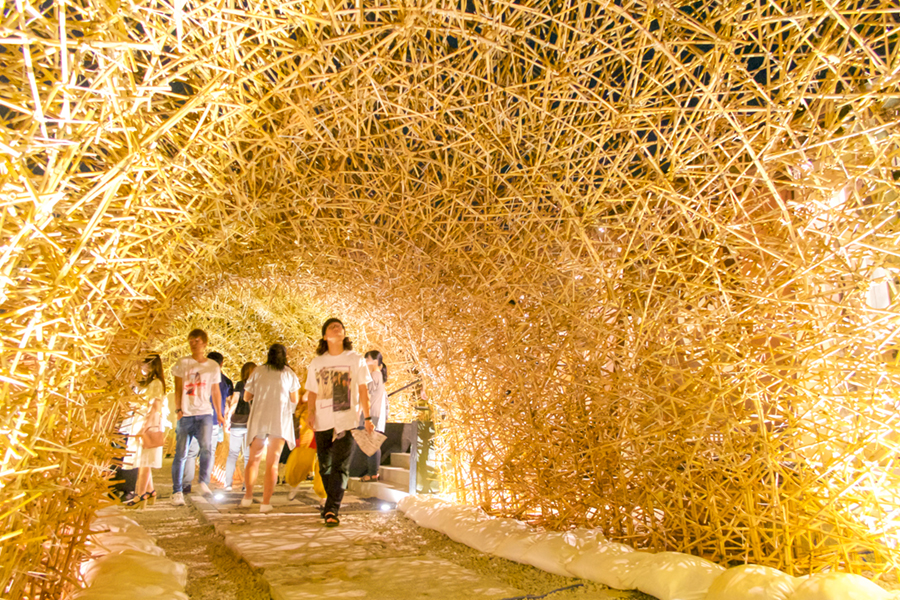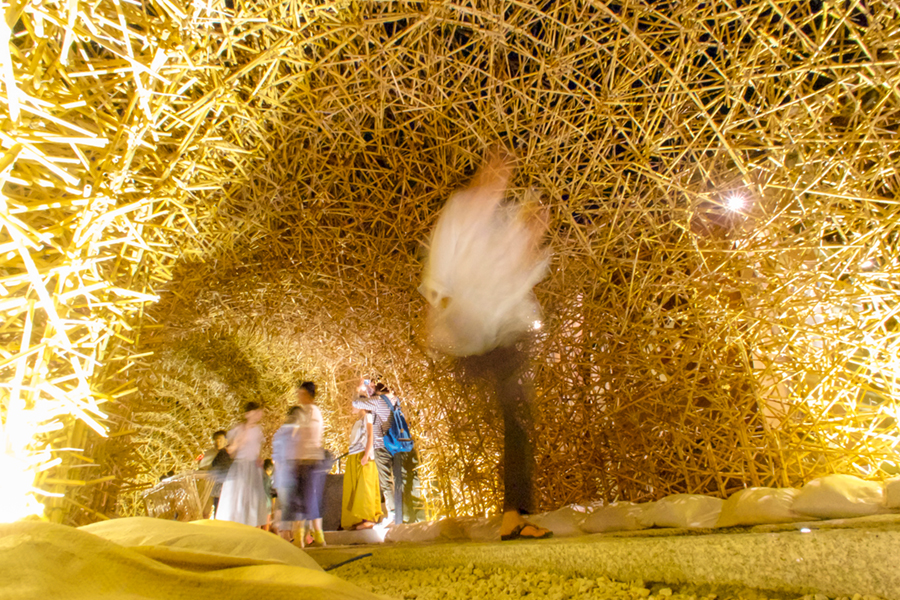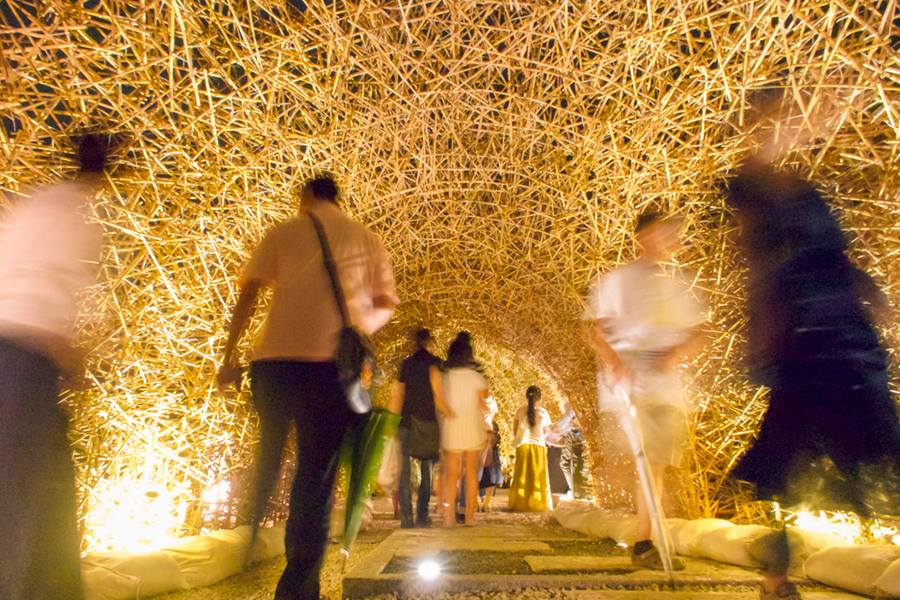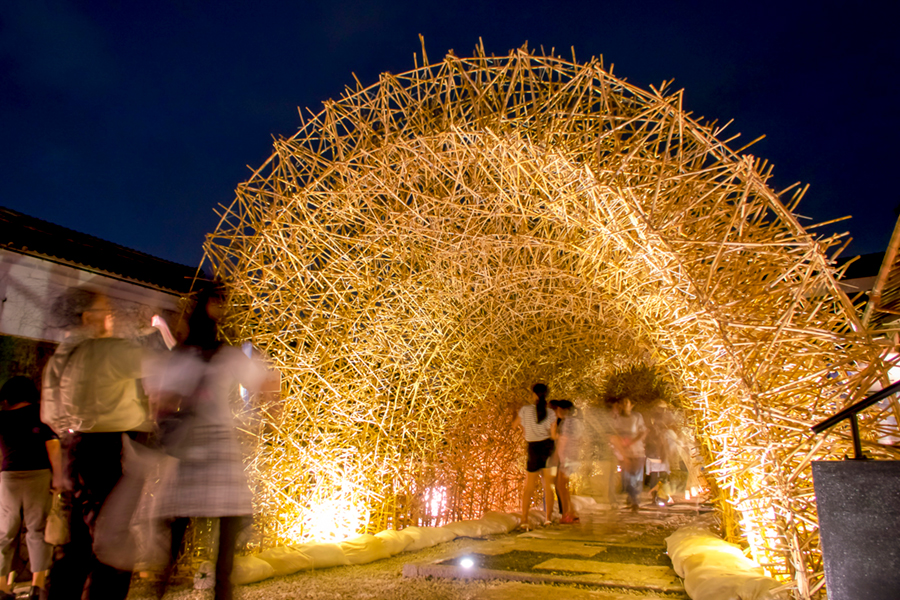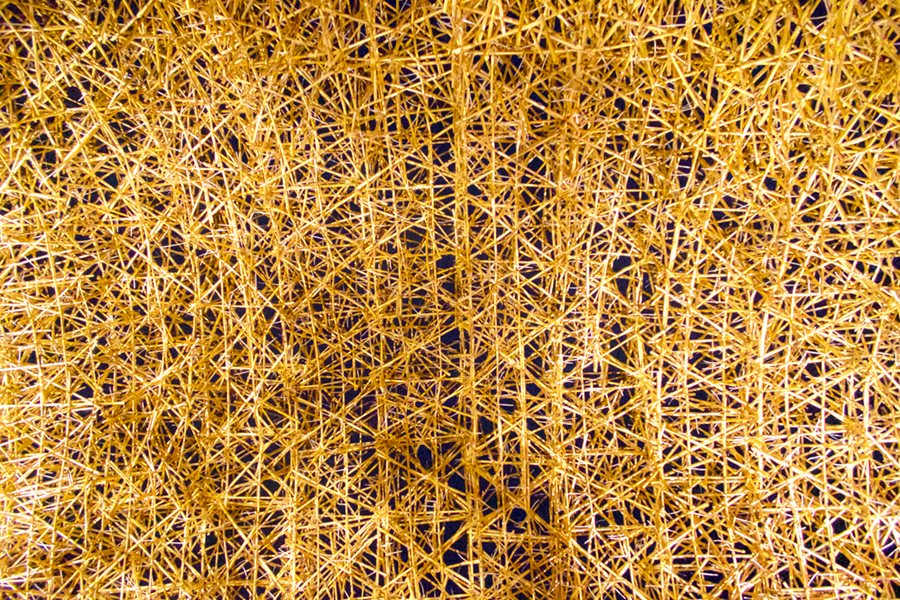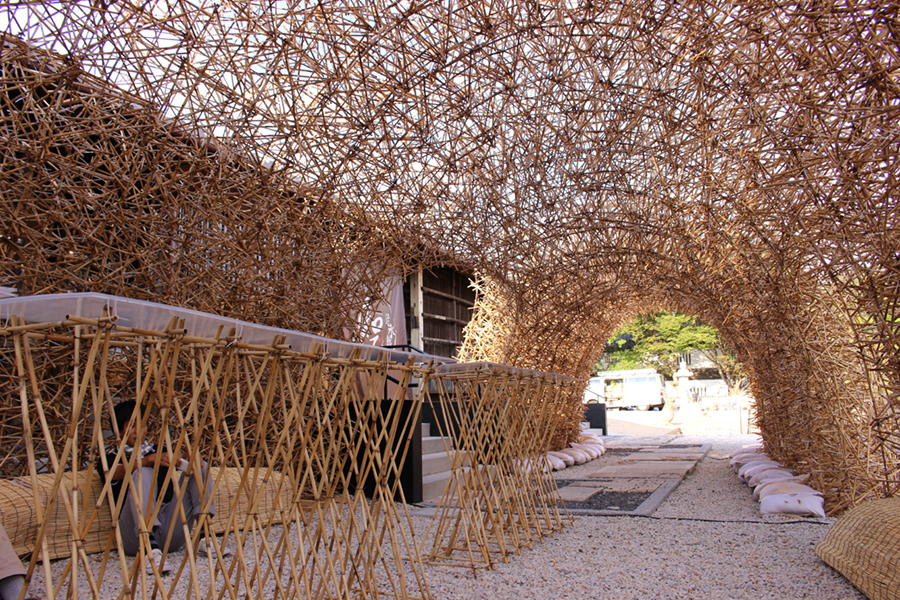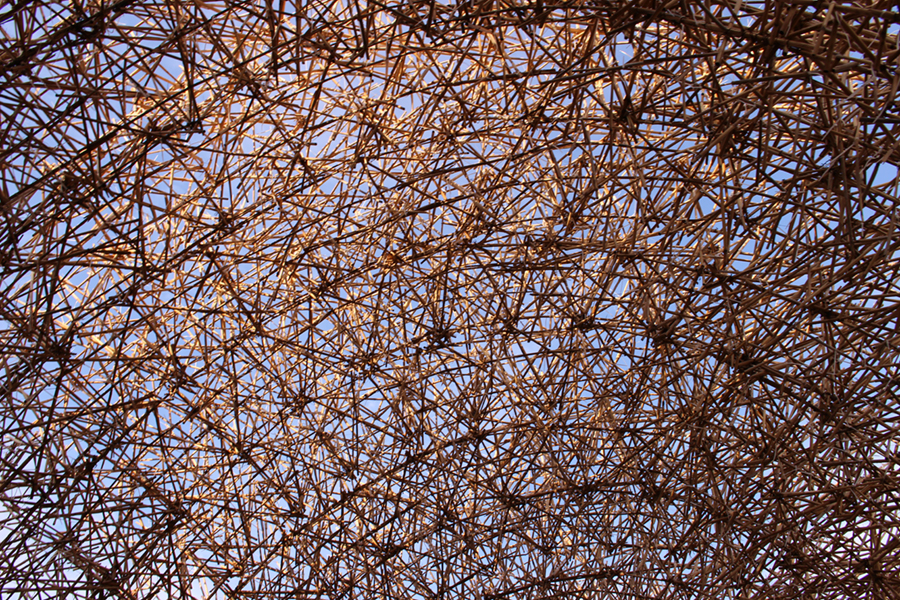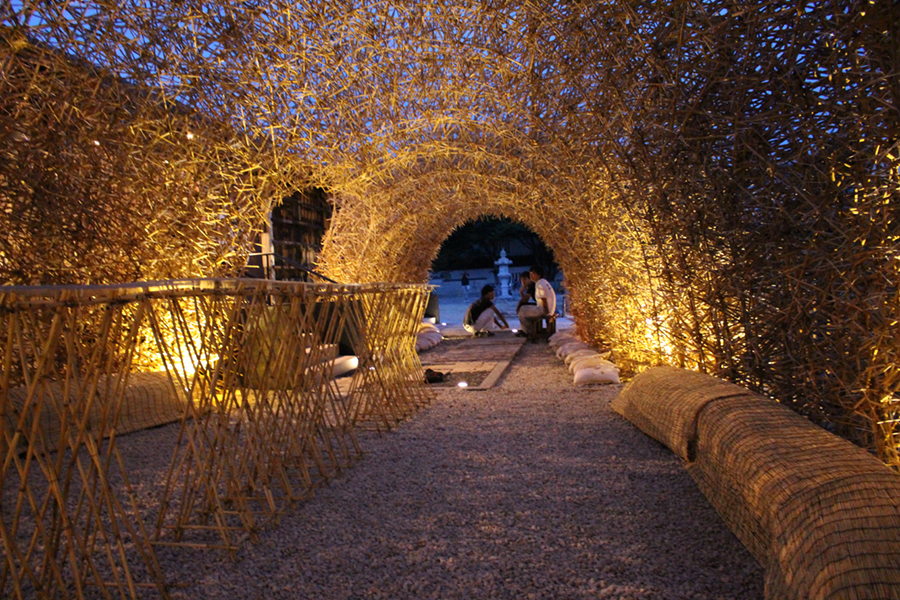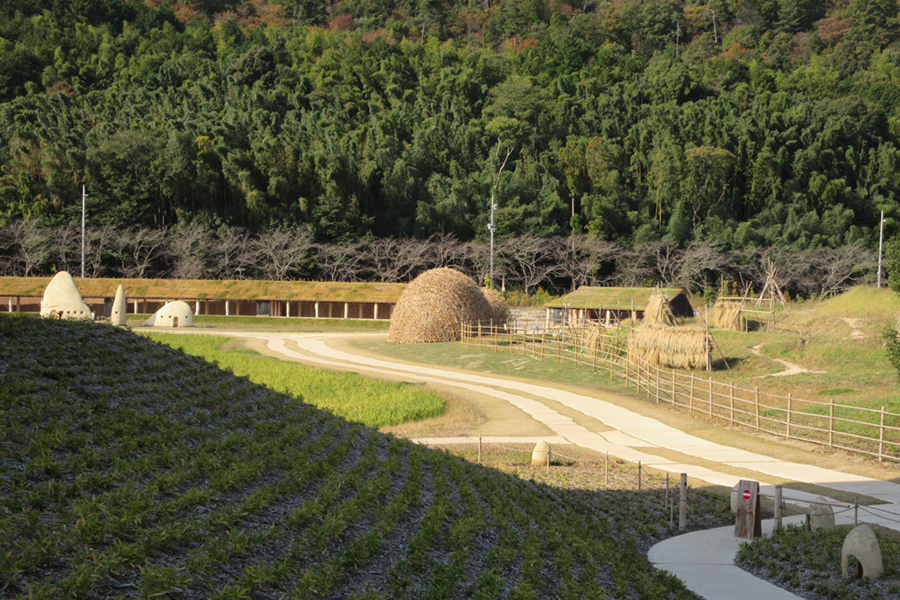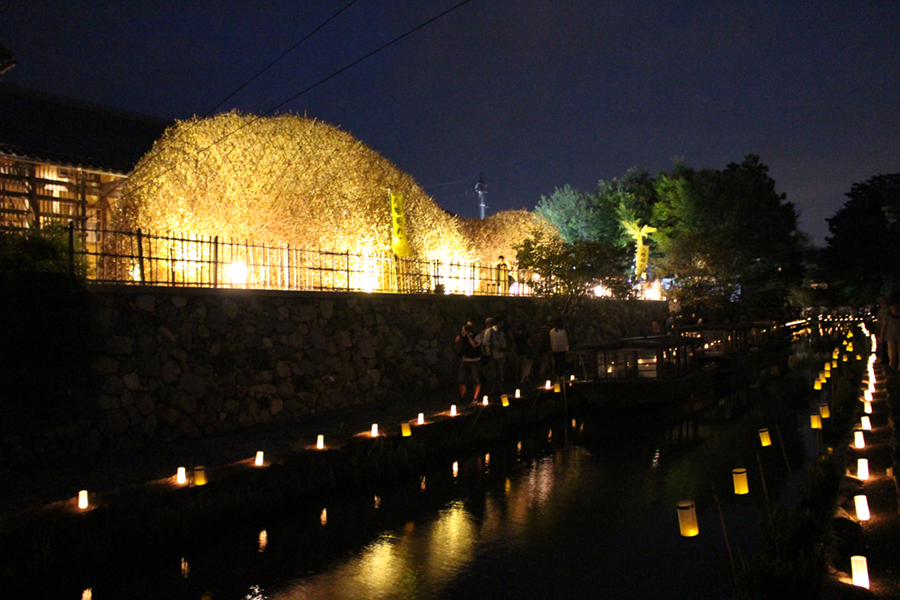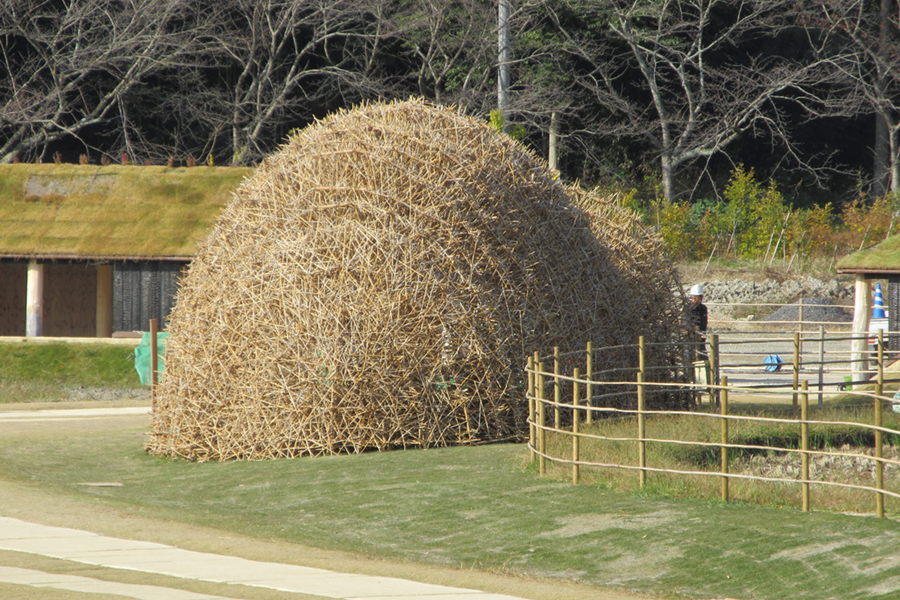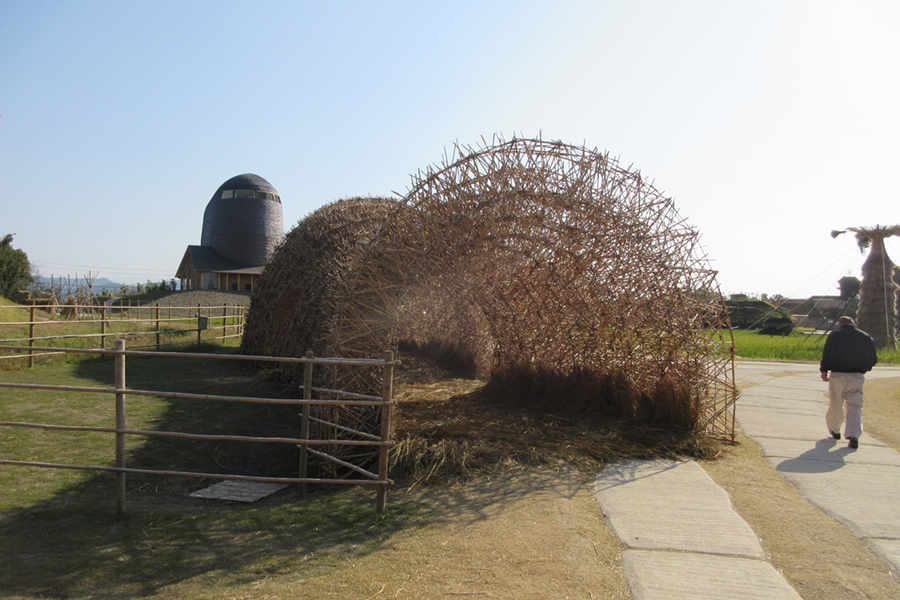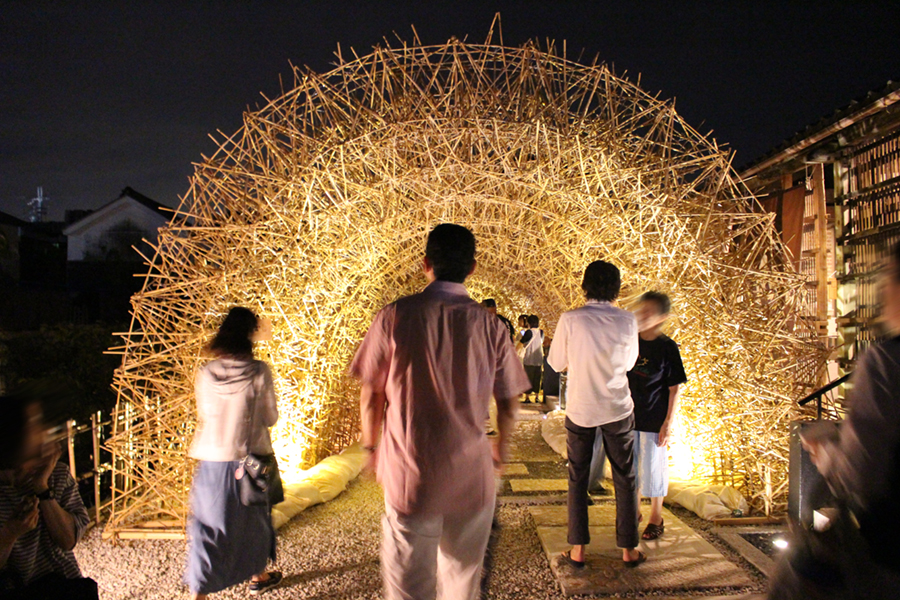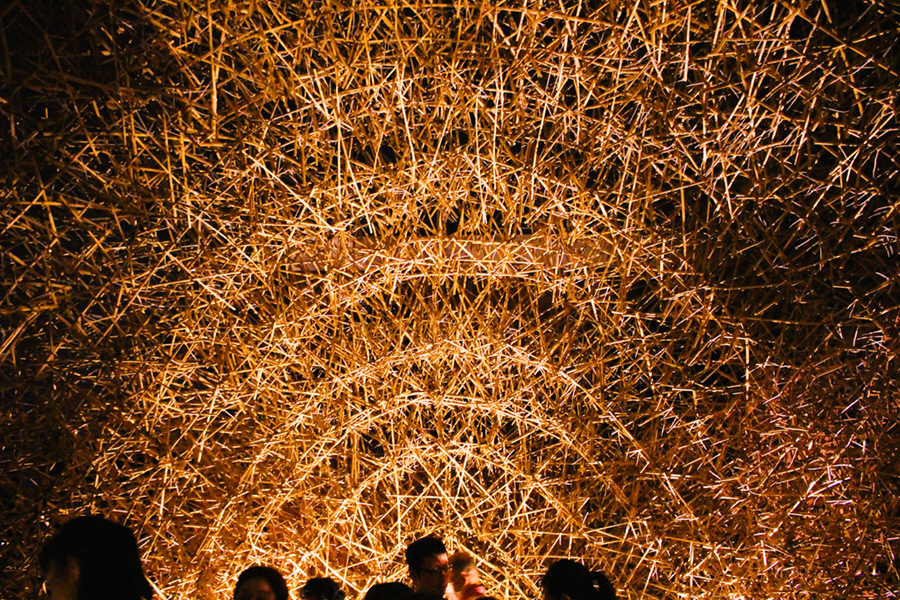滋賀県立大学 永井拓生+サステナブル構造デザイン研究室
THE UNIVERSITY OF SHIGA PREFECTURE
滋賀県立大学 永井拓生+サステナブル構造デザイン研究室
THE UNIVERSITY OF SHIGA PREFECTURE
滋賀県立大学 永井拓生+サステナブル構造デザイン研究室
THE UNIVERSITY OF SHIGA PREFECTURE
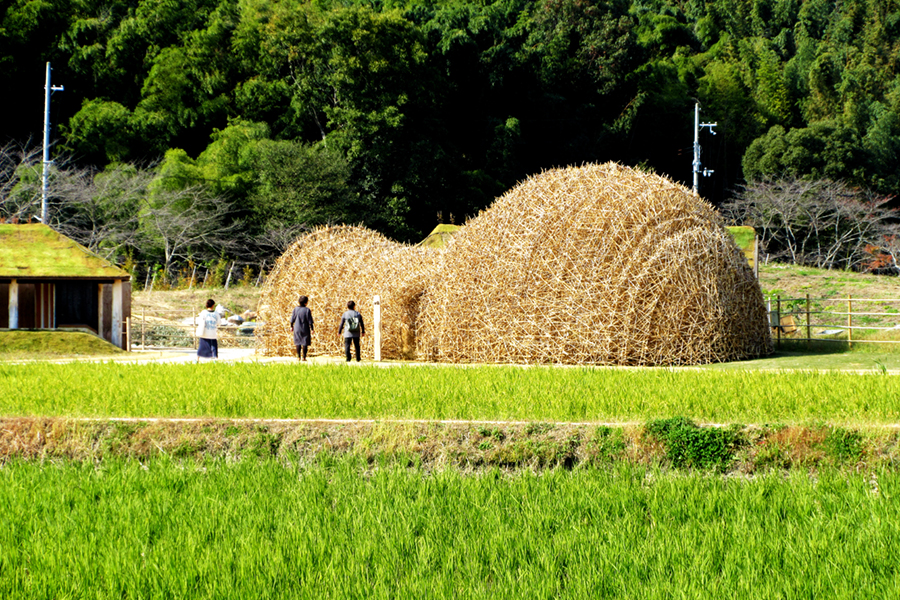
Lake Nishi-no-ko, the largest remaining oxbow lake of Lake Biwa, lies in the city of Omihachiman. The expansive reed beds along its shores form a landscape unique to this region. However, due to the decline of the local reed industry, these reed fields are no longer adequately maintained and have overgrown to the extent of obstructing views of the lake. In response to growing concern over this situation, community members and the University of Shiga Prefecture began collaborating to explore new ways to utilize reed as a tourism resource.
As an initial step, a reed pavilion was designed and built for the Hachiman-bori Festival, a two-day annual event held in September that attracts approximately 30,000 visitors. The design goals were twofold: to create a structure made entirely of reed, and to use as much reed as possible. Since the festival is a nighttime event illuminated by thousands of candles, the team envisioned a pavilion that would appear as a delicate, glowing mass of reeds suspended in the evening darkness.
However, the use of large amounts of reed posed a challenge—more reed meant more joints. With limited time for construction, the key issue became how to connect thousands of reeds quickly yet securely. Through trial and error, the team decided to use commercially available zip ties and galvanized wire. While zip ties allow for rapid assembly, wire provides superior strength and stiffness. A hybrid approach was adopted: wire was used for high-stress joints, while zip ties were used elsewhere.
The pavilion was constructed over the course of a two-week workshop, led primarily by students of the University of Shiga Prefecture. During the festival held on September 17 and 18, 2016, the illuminated Reed Dome attracted crowds so large that it became difficult to move around it. After the event, the structure was relocated to the garden of La Collina Omihachiman, a facility operated by the Taneya Group. There, staff thoughtfully considered how best to display it. Seeing children play joyfully in and around the dome, it felt as though the project had succeeded in creating a space that truly embodied the spirit of the region.
The site was a long, trapezoidal plot facing the Hachiman-bori canal, with a slightly wider rear end. A dome-shaped space with a full-width span was created in the broader area, while a tunnel-like space with a gradually varying height and width extended toward the entrance. The total length of the structure was approximately 16 meters, with a maximum span of 6 meters and a height ranging from 2.5 to 4.5 meters. It was composed of 35 planar arches arranged along the longitudinal axis.
Each arch was formed as a spatial truss using bundles of reed. To ensure structural integrity in all directions, a semi-random truss configuration was adopted, combining a basic cubic lattice with truss elements placed in a multi-directional, semi-random pattern. While zip ties allowed for connections in a matter of seconds, wire provided superior strength and rigidity. Therefore, wire was used for critical joints experiencing high stress, while zip ties sufficed for the rest.
The Reed Dome weighed only about 250 kgf, making it an extremely lightweight structure where wind load became a critical factor. In the transverse direction, wind loads were resisted through in-plane forces of each arch. In the longitudinal direction, because the projected wind area was small, sufficient resistance could be achieved by securely connecting the arches together.
Each arch was pre-assembled on the ground and then raised into position sequentially, starting from the area with the highest rise. To counter uplift forces, sandbags were used as counterweights at the base of each column. Bamboo blinds were laid over the sandbags, allowing them to serve as benches. Approximately 20,000 reeds were used, and the total labor amounted to 230 person-days.
Design and construction: Hiromasa Shirai Lab + Takuo Nagai Lab + Volunteer students from the University of Shiga Prefecture
Advisor: Takeo Matsuoka
Program: Pavilion
Year of completion: 2016
Photo courtesy of Jun Kinoshita, Shintaro Taguchi, Takuo Nagai
近江八幡市の西の湖は現存する琵琶湖の内湖として最大であり,湖岸に広がるヨシ原はこの地域ならではの景観である。しかし,ヨシ産業の衰退に伴い管理が行き届かなくなったヨシは,湖の風景を遮るほどに繁茂している。このような状況を危惧する声は多く,地元の有志と滋賀県立大学が協力し,観光資源としてのヨシの新たな利用の模索を始めた。まずは,毎年9月に行われ2日間で約3万人が来場する八幡堀祭りに合わせ,ヨシを使ったパビリオンを制作することになった。
ヨシを使う上で,ヨシのみで成立する構造に拘ること,なるべく沢山のヨシを使うことを目標にした。八幡堀祭りは夕方以降に八幡堀を蝋燭で彩る夜の祭りである。繊細な無数のヨシの塊が,夕闇にぼんやりと浮かび上がるような形にしたいと考えた。しかし,沢山のヨシを使うことは接合作業が増大することでもある。限られた制作期間で多くのヨシを接合し,かつ十分な強度を持たせるかが課題だったが,試行錯誤の末,市販の結束バンドと番線で接合することにした。
制作は滋賀県立大学の学生が中心となって行い,2週間の合宿生活の末に完成させた。9月17日・18日の八幡堀祭りには大勢の観光客が訪れ,ライトアップされたヨシドームは身動きがとれないほどの盛況となった。その後,たねやグループの「ラコリーナ近江八幡」の庭園内に移築した。たねやスタッフの方々が配置や見せ方を相当に考えてくれた。子供達がヨシドームの内外で楽しそうに遊んでいるのを見ると,ヨシを使った「この地域ならではの空間」と言えるものができたのではないかと思う。
敷地は八幡堀に面した細長い台形で,奥のほうがやや幅が広い。その部分に幅いっぱいのスパンを持つドーム状の空間を作り,入口側に向かって高さと幅に変化をつけたトンネル状の空間を接続した。全長約16m,最大スパン6m,高さ2.5~4.5mである。これを長手方向に35通りの平面アーチに分割して作る。
各アーチはヨシを立体的に組んだトラスアーチである。あらゆる方向に強度を高めるには,立方格子状の基本形と全方位にランダムに配置されたトラスの組み合わせからなる,セミランダムトラス構造とした。結束バンドを結ぶ作業は数秒なので全部これですませたかったが,番線のほうが作業に時間はかかるが接合部の強度・剛性とも優れる。そこで,応力が大きな部材同士は番線,それ以外は結束バンドと使い分けている。
ヨシドームは重量約250kgfと極めて軽量な構造体であり,風荷重がクリティカルとなる。短手方向の風荷重は各アーチの面内力で抵抗させ,長手方向は風荷重の見附面積が小さいため,アーチ同士をしっかり接続すれば十分である。
各アーチを地組みして作り,最もライズの高い箇所から順次立ち並べ接続していった。吹上げ力に対しては土嚢をカウンターウェイトとして柱脚に固定し,その上にすだれを敷いてベンチとしても使えるようにした。用いたヨシは立木で約2万本,完成までの延べ人工は230人日であった。
設計・施工:白井宏昌研究室+永井拓生研究室+滋賀県立大学学生有志
アドバイザー:松岡拓公雄
用途:パビリオン
完成年:2016年
写真:木下潤,田口真太郎,永井拓生
